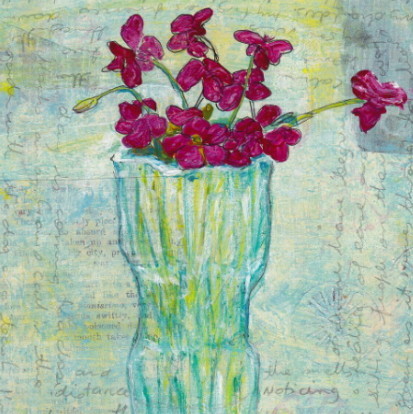How do you feel when you face a blank page?
Some days it’s not a big deal for me, some days it’s difficult.
When it’s good, writing and creating is like something fresh and vivid pouring itself onto the paper.
Then there’s the not-good times. The block shows up first in my body–as heat, as tension–it’s like I’m a thermometer and the red mercury of dread is rising up through me.
That feeling reminds me of exams I’ve taken where I sat, pen in hand, mortified as every drop of knowledge evaporates, leaving me stuck on a hard seat staring at the sheet of paper demanding answers from me.
Most of my experience of writer’s block is somehow related to false expectations. Set by me, or a someone else, as if I’m being examined and about to be ‘found out’ as lacking something.
I’ve developed a practice that helps me with all of these things, that is changing my relationship to writing, it’s called ‘noticing’.
Noticing is my way of dissolving false expectations, and tapping into what lies underneath all of that anxiety. It’s a way of claiming a small victory for myself. the small victory of starting. Which often leads to a snowballing effect–once I’ve pierced the crust of my anxiety I’m free to mine all the good that lies beneath it.
This Is How It Works
Start by writing the word ‘noticing’ at the top of your page, and begin to write whatever comes into your awareness, in this moment. Anything counts, if the pen is moving, this is working. There is no quality requirement here, we just record what’s happening in the moment, even that is just a starting point, if you veer away that’s fine, too.
Whenever you get stuck, or need a moment to regather, or simply want to follow a new train of thought write the word ‘noticing’ again keep the pen moving:
Noticing the boys walking outside my window, chatting away. The sound of geese? ducks? the light is low and I see grey through the window. The room is warm. Noticing tension in my head. At my temples. I’m tired and flat. Noticing the light falling on the page, how my hand casts a shadow over the tip of my pen and each word is written in shadow then moves into the light as my hand moves across
The repetition of the word noticing does a few things. First of all, writing the word noticing means that before I come up with my own first word, ink has already met the paper: no blank page. It sounds insignificant, but with writer’s block there are no insignificant victories. There’s writing, and there’s not writing.
The word noticing also gives me a focus, I have a clear simple action to perform, that keeps me from spinning my wheels.
I also like the rhythm of the word: ‘no-ti-cing‘. I often write it out a few times when I’m stuck and just enjoy that rhythm, and what it draws out from me:
noticing noticing noticing … a plane flying overhead, the small of my back is tight, I’m leaning forward in my chair, now shifting a little, my back has eased slightly , still tight. the window just brightened, the sun is out and there’s a mess of garden hose all lit up on the ground outside.
No grammar check, no spell check, no checking anything here. The exercise is all about getting the pen moving, and touching base with your present moment experience.
Noticing is for everybody. The great thing about this exercise is you can’t get it wrong, because you’re just recording what is coming into your field of attention as it happens. And also, you can’t get it right, because no matter how fast you write you can’t possibly capture with pen and hand all the things that are you are noticing in any given moment.
Ideas of right and wrong become completely irrelevant. Take that! Inner Critic.
It’s a great practice to begin a writing session–that’s my favourite use. I also find it calming, and will often ‘notice’ for a few minutes before writing an email, or filling out a form I’ve been stressed about, or even if I just want to sit and do some journalling (I never know what to journal about, so noticing is really helpful there. )
I’ll sometimes take a pen and paper out into the garden when I’m supervising my son’s play, too. It’s nice to sit out there with a cup of tea, do a bit of noticing, run around with the boys for a while, do some more noticing. It’s a great way to check in and touch base.
You can go as lightly or deeply as you choose to with this. Sometimes, I’ll start off noticing and hit an idea or a feeling that really draws me in and the noticing becomes something else entirely– a blog post, a starting point for a poem, or a painting.
Anything can happen.
And Hey! Did you know I’ve written a whole ebook on noticing for you?
It’s called ‘Notice Your Life’ and it’s free for you to download right now!
Just fill out the form at the bottom of the page, then hit that big orange button to get your copy delivered.
You will also receive the Welcome Presence newsletter with tips, blog updates, and conversations on being more present in the world.
Cheers!


